Business Law (BLAW300) Assessment 2: Contract Law Case Analysis
VerifiedAdded on 2023/01/19
|12
|3050
|60
Homework Assignment
AI Summary
This document provides solutions to two Business Law assignments. The first assignment addresses contract law principles through case studies, examining offer and acceptance, misrepresentation, and illegal contracts, providing detailed legal analysis of each scenario. The second assignment focuses on business structures, comparing sole proprietorships, partnerships, companies, and trusts, and discussing the implications of incorporation and financing options for businesses. The document offers insights into the advantages and disadvantages of each structure, and how these legal concepts apply to real-world business situations, providing a comprehensive overview of relevant legal principles.
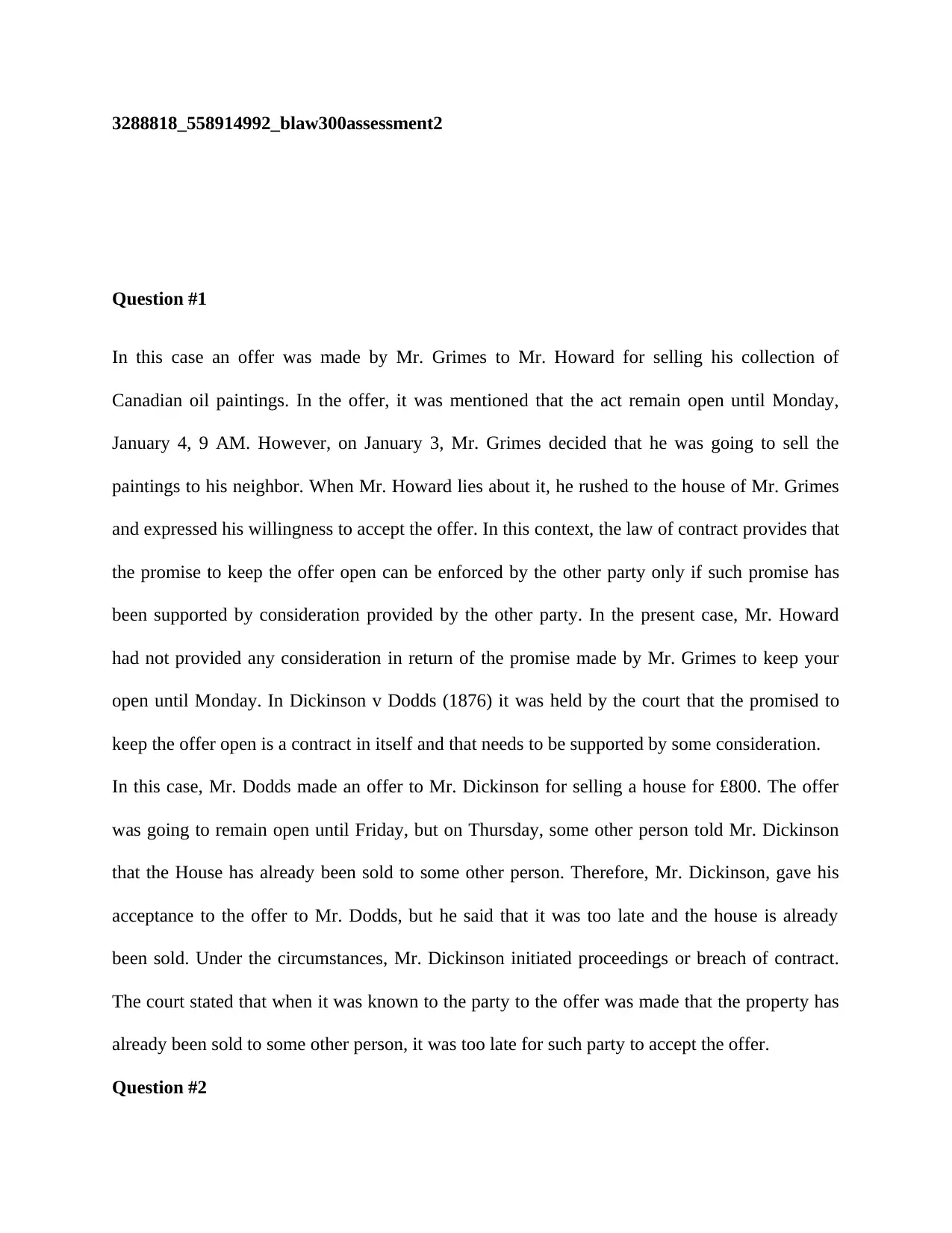
3288818_558914992_blaw300assessment2
Question #1
In this case an offer was made by Mr. Grimes to Mr. Howard for selling his collection of
Canadian oil paintings. In the offer, it was mentioned that the act remain open until Monday,
January 4, 9 AM. However, on January 3, Mr. Grimes decided that he was going to sell the
paintings to his neighbor. When Mr. Howard lies about it, he rushed to the house of Mr. Grimes
and expressed his willingness to accept the offer. In this context, the law of contract provides that
the promise to keep the offer open can be enforced by the other party only if such promise has
been supported by consideration provided by the other party. In the present case, Mr. Howard
had not provided any consideration in return of the promise made by Mr. Grimes to keep your
open until Monday. In Dickinson v Dodds (1876) it was held by the court that the promised to
keep the offer open is a contract in itself and that needs to be supported by some consideration.
In this case, Mr. Dodds made an offer to Mr. Dickinson for selling a house for £800. The offer
was going to remain open until Friday, but on Thursday, some other person told Mr. Dickinson
that the House has already been sold to some other person. Therefore, Mr. Dickinson, gave his
acceptance to the offer to Mr. Dodds, but he said that it was too late and the house is already
been sold. Under the circumstances, Mr. Dickinson initiated proceedings or breach of contract.
The court stated that when it was known to the party to the offer was made that the property has
already been sold to some other person, it was too late for such party to accept the offer.
Question #2
Question #1
In this case an offer was made by Mr. Grimes to Mr. Howard for selling his collection of
Canadian oil paintings. In the offer, it was mentioned that the act remain open until Monday,
January 4, 9 AM. However, on January 3, Mr. Grimes decided that he was going to sell the
paintings to his neighbor. When Mr. Howard lies about it, he rushed to the house of Mr. Grimes
and expressed his willingness to accept the offer. In this context, the law of contract provides that
the promise to keep the offer open can be enforced by the other party only if such promise has
been supported by consideration provided by the other party. In the present case, Mr. Howard
had not provided any consideration in return of the promise made by Mr. Grimes to keep your
open until Monday. In Dickinson v Dodds (1876) it was held by the court that the promised to
keep the offer open is a contract in itself and that needs to be supported by some consideration.
In this case, Mr. Dodds made an offer to Mr. Dickinson for selling a house for £800. The offer
was going to remain open until Friday, but on Thursday, some other person told Mr. Dickinson
that the House has already been sold to some other person. Therefore, Mr. Dickinson, gave his
acceptance to the offer to Mr. Dodds, but he said that it was too late and the house is already
been sold. Under the circumstances, Mr. Dickinson initiated proceedings or breach of contract.
The court stated that when it was known to the party to the offer was made that the property has
already been sold to some other person, it was too late for such party to accept the offer.
Question #2
Paraphrase This Document
Need a fresh take? Get an instant paraphrase of this document with our AI Paraphraser
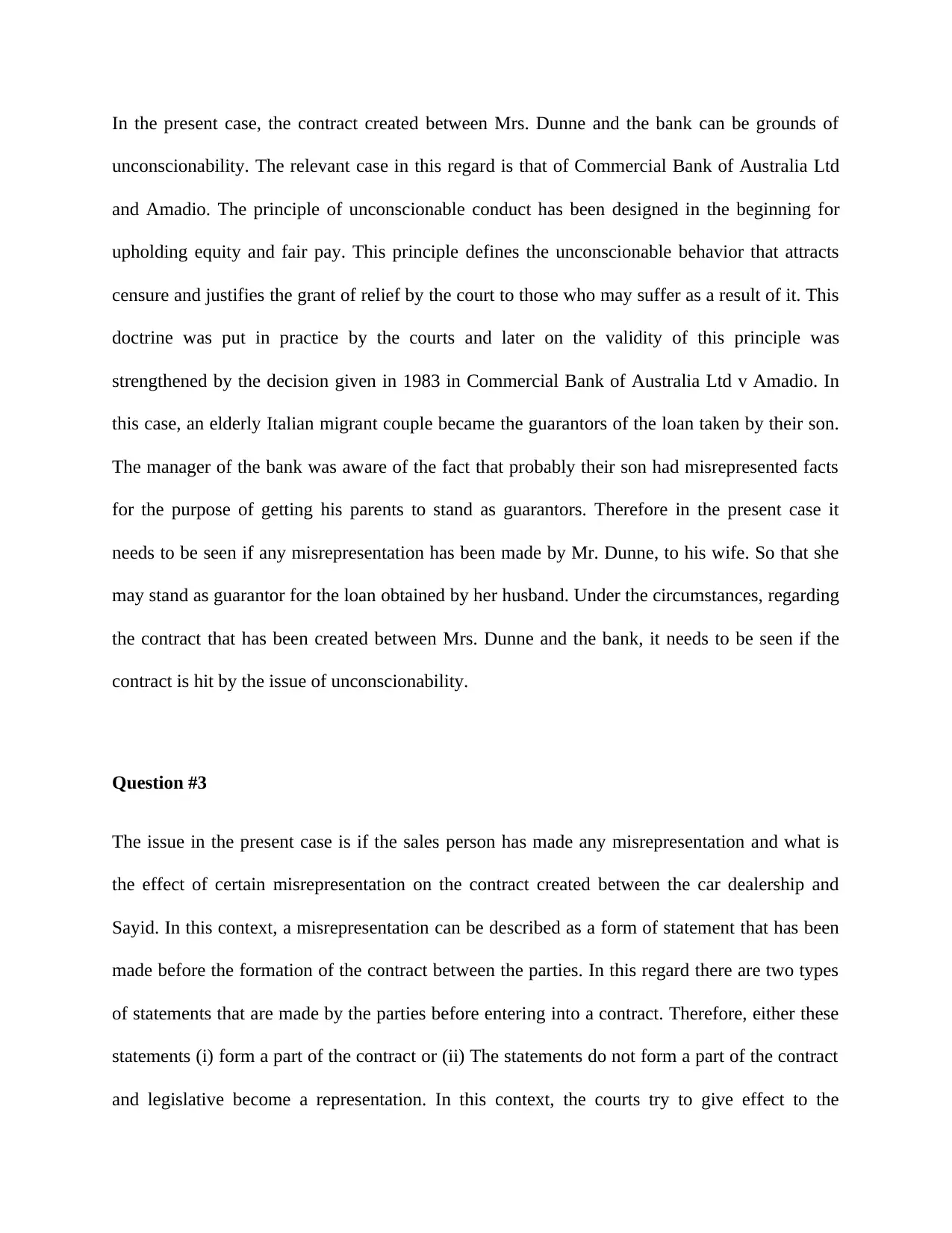
In the present case, the contract created between Mrs. Dunne and the bank can be grounds of
unconscionability. The relevant case in this regard is that of Commercial Bank of Australia Ltd
and Amadio. The principle of unconscionable conduct has been designed in the beginning for
upholding equity and fair pay. This principle defines the unconscionable behavior that attracts
censure and justifies the grant of relief by the court to those who may suffer as a result of it. This
doctrine was put in practice by the courts and later on the validity of this principle was
strengthened by the decision given in 1983 in Commercial Bank of Australia Ltd v Amadio. In
this case, an elderly Italian migrant couple became the guarantors of the loan taken by their son.
The manager of the bank was aware of the fact that probably their son had misrepresented facts
for the purpose of getting his parents to stand as guarantors. Therefore in the present case it
needs to be seen if any misrepresentation has been made by Mr. Dunne, to his wife. So that she
may stand as guarantor for the loan obtained by her husband. Under the circumstances, regarding
the contract that has been created between Mrs. Dunne and the bank, it needs to be seen if the
contract is hit by the issue of unconscionability.
Question #3
The issue in the present case is if the sales person has made any misrepresentation and what is
the effect of certain misrepresentation on the contract created between the car dealership and
Sayid. In this context, a misrepresentation can be described as a form of statement that has been
made before the formation of the contract between the parties. In this regard there are two types
of statements that are made by the parties before entering into a contract. Therefore, either these
statements (i) form a part of the contract or (ii) The statements do not form a part of the contract
and legislative become a representation. In this context, the courts try to give effect to the
unconscionability. The relevant case in this regard is that of Commercial Bank of Australia Ltd
and Amadio. The principle of unconscionable conduct has been designed in the beginning for
upholding equity and fair pay. This principle defines the unconscionable behavior that attracts
censure and justifies the grant of relief by the court to those who may suffer as a result of it. This
doctrine was put in practice by the courts and later on the validity of this principle was
strengthened by the decision given in 1983 in Commercial Bank of Australia Ltd v Amadio. In
this case, an elderly Italian migrant couple became the guarantors of the loan taken by their son.
The manager of the bank was aware of the fact that probably their son had misrepresented facts
for the purpose of getting his parents to stand as guarantors. Therefore in the present case it
needs to be seen if any misrepresentation has been made by Mr. Dunne, to his wife. So that she
may stand as guarantor for the loan obtained by her husband. Under the circumstances, regarding
the contract that has been created between Mrs. Dunne and the bank, it needs to be seen if the
contract is hit by the issue of unconscionability.
Question #3
The issue in the present case is if the sales person has made any misrepresentation and what is
the effect of certain misrepresentation on the contract created between the car dealership and
Sayid. In this context, a misrepresentation can be described as a form of statement that has been
made before the formation of the contract between the parties. In this regard there are two types
of statements that are made by the parties before entering into a contract. Therefore, either these
statements (i) form a part of the contract or (ii) The statements do not form a part of the contract
and legislative become a representation. In this context, the courts try to give effect to the
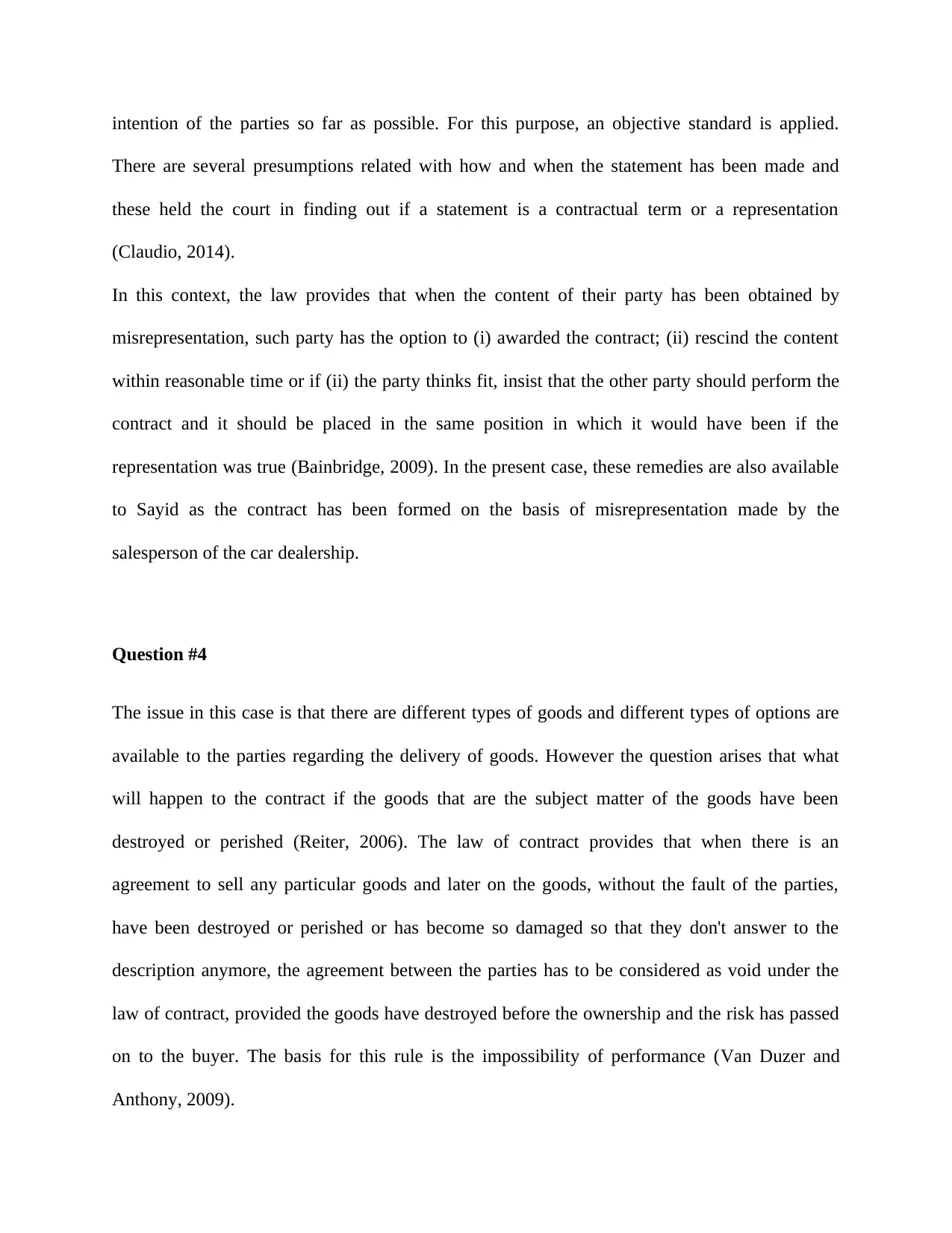
intention of the parties so far as possible. For this purpose, an objective standard is applied.
There are several presumptions related with how and when the statement has been made and
these held the court in finding out if a statement is a contractual term or a representation
(Claudio, 2014).
In this context, the law provides that when the content of their party has been obtained by
misrepresentation, such party has the option to (i) awarded the contract; (ii) rescind the content
within reasonable time or if (ii) the party thinks fit, insist that the other party should perform the
contract and it should be placed in the same position in which it would have been if the
representation was true (Bainbridge, 2009). In the present case, these remedies are also available
to Sayid as the contract has been formed on the basis of misrepresentation made by the
salesperson of the car dealership.
Question #4
The issue in this case is that there are different types of goods and different types of options are
available to the parties regarding the delivery of goods. However the question arises that what
will happen to the contract if the goods that are the subject matter of the goods have been
destroyed or perished (Reiter, 2006). The law of contract provides that when there is an
agreement to sell any particular goods and later on the goods, without the fault of the parties,
have been destroyed or perished or has become so damaged so that they don't answer to the
description anymore, the agreement between the parties has to be considered as void under the
law of contract, provided the goods have destroyed before the ownership and the risk has passed
on to the buyer. The basis for this rule is the impossibility of performance (Van Duzer and
Anthony, 2009).
There are several presumptions related with how and when the statement has been made and
these held the court in finding out if a statement is a contractual term or a representation
(Claudio, 2014).
In this context, the law provides that when the content of their party has been obtained by
misrepresentation, such party has the option to (i) awarded the contract; (ii) rescind the content
within reasonable time or if (ii) the party thinks fit, insist that the other party should perform the
contract and it should be placed in the same position in which it would have been if the
representation was true (Bainbridge, 2009). In the present case, these remedies are also available
to Sayid as the contract has been formed on the basis of misrepresentation made by the
salesperson of the car dealership.
Question #4
The issue in this case is that there are different types of goods and different types of options are
available to the parties regarding the delivery of goods. However the question arises that what
will happen to the contract if the goods that are the subject matter of the goods have been
destroyed or perished (Reiter, 2006). The law of contract provides that when there is an
agreement to sell any particular goods and later on the goods, without the fault of the parties,
have been destroyed or perished or has become so damaged so that they don't answer to the
description anymore, the agreement between the parties has to be considered as void under the
law of contract, provided the goods have destroyed before the ownership and the risk has passed
on to the buyer. The basis for this rule is the impossibility of performance (Van Duzer and
Anthony, 2009).
⊘ This is a preview!⊘
Do you want full access?
Subscribe today to unlock all pages.

Trusted by 1+ million students worldwide
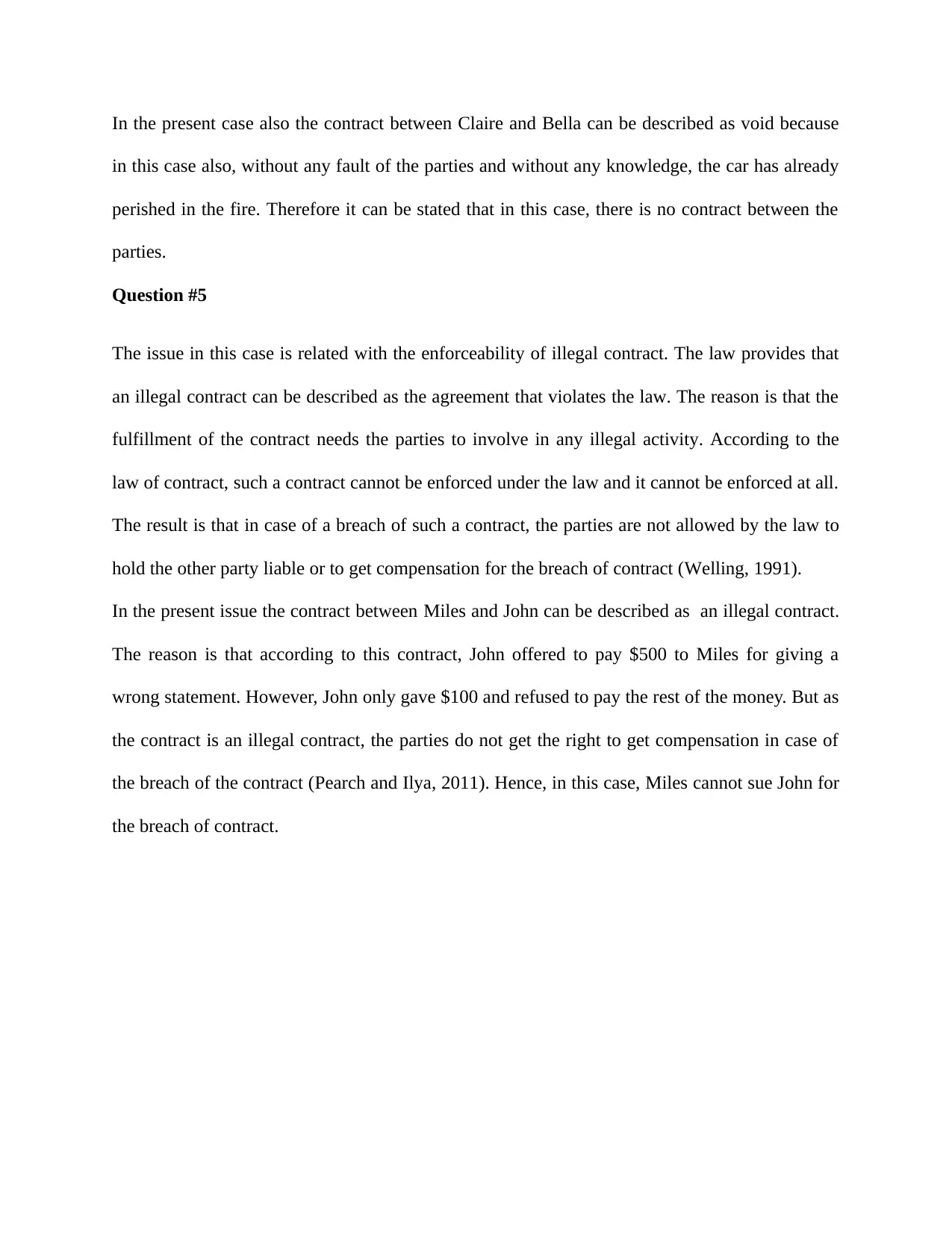
In the present case also the contract between Claire and Bella can be described as void because
in this case also, without any fault of the parties and without any knowledge, the car has already
perished in the fire. Therefore it can be stated that in this case, there is no contract between the
parties.
Question #5
The issue in this case is related with the enforceability of illegal contract. The law provides that
an illegal contract can be described as the agreement that violates the law. The reason is that the
fulfillment of the contract needs the parties to involve in any illegal activity. According to the
law of contract, such a contract cannot be enforced under the law and it cannot be enforced at all.
The result is that in case of a breach of such a contract, the parties are not allowed by the law to
hold the other party liable or to get compensation for the breach of contract (Welling, 1991).
In the present issue the contract between Miles and John can be described as an illegal contract.
The reason is that according to this contract, John offered to pay $500 to Miles for giving a
wrong statement. However, John only gave $100 and refused to pay the rest of the money. But as
the contract is an illegal contract, the parties do not get the right to get compensation in case of
the breach of the contract (Pearch and Ilya, 2011). Hence, in this case, Miles cannot sue John for
the breach of contract.
in this case also, without any fault of the parties and without any knowledge, the car has already
perished in the fire. Therefore it can be stated that in this case, there is no contract between the
parties.
Question #5
The issue in this case is related with the enforceability of illegal contract. The law provides that
an illegal contract can be described as the agreement that violates the law. The reason is that the
fulfillment of the contract needs the parties to involve in any illegal activity. According to the
law of contract, such a contract cannot be enforced under the law and it cannot be enforced at all.
The result is that in case of a breach of such a contract, the parties are not allowed by the law to
hold the other party liable or to get compensation for the breach of contract (Welling, 1991).
In the present issue the contract between Miles and John can be described as an illegal contract.
The reason is that according to this contract, John offered to pay $500 to Miles for giving a
wrong statement. However, John only gave $100 and refused to pay the rest of the money. But as
the contract is an illegal contract, the parties do not get the right to get compensation in case of
the breach of the contract (Pearch and Ilya, 2011). Hence, in this case, Miles cannot sue John for
the breach of contract.
Paraphrase This Document
Need a fresh take? Get an instant paraphrase of this document with our AI Paraphraser
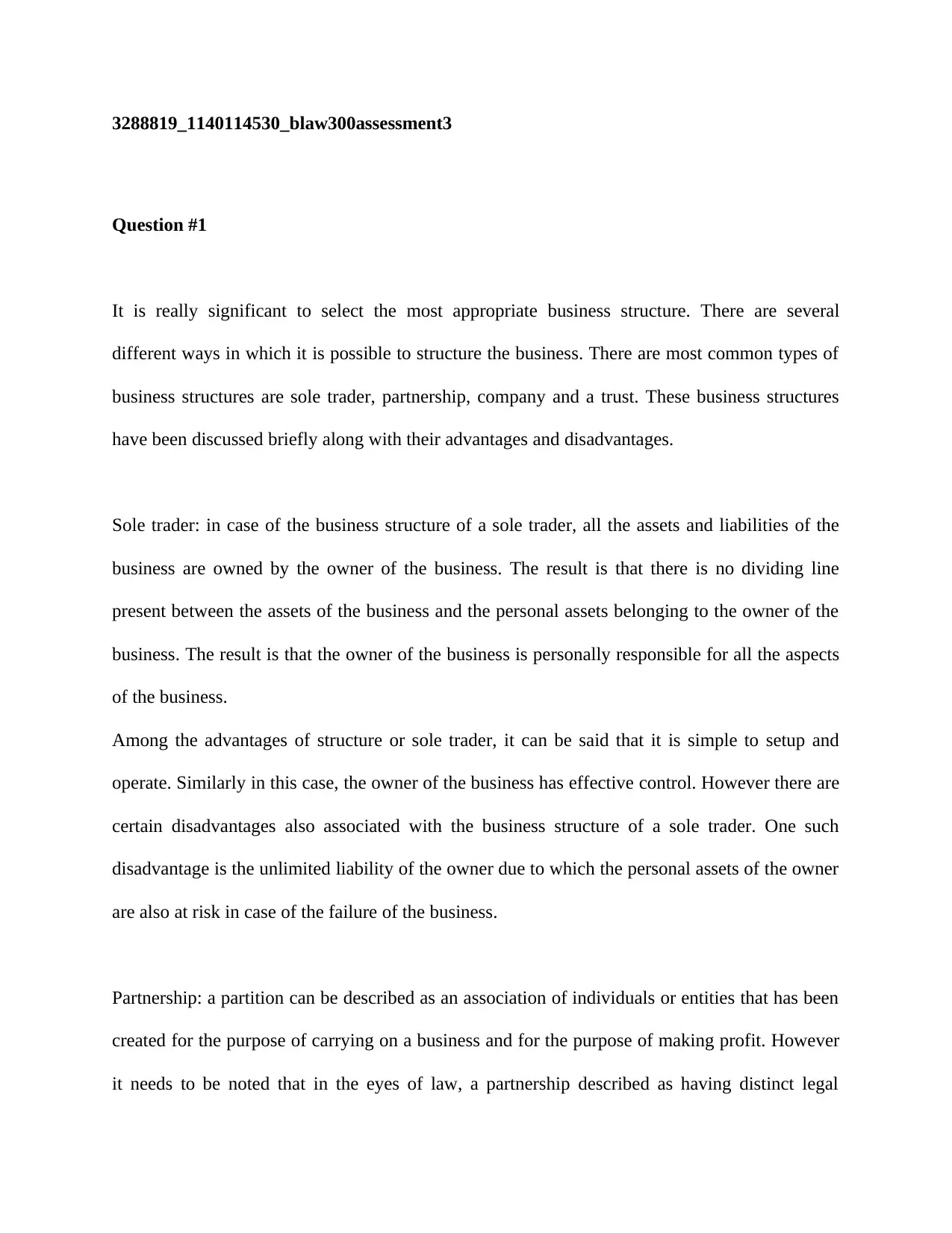
3288819_1140114530_blaw300assessment3
Question #1
It is really significant to select the most appropriate business structure. There are several
different ways in which it is possible to structure the business. There are most common types of
business structures are sole trader, partnership, company and a trust. These business structures
have been discussed briefly along with their advantages and disadvantages.
Sole trader: in case of the business structure of a sole trader, all the assets and liabilities of the
business are owned by the owner of the business. The result is that there is no dividing line
present between the assets of the business and the personal assets belonging to the owner of the
business. The result is that the owner of the business is personally responsible for all the aspects
of the business.
Among the advantages of structure or sole trader, it can be said that it is simple to setup and
operate. Similarly in this case, the owner of the business has effective control. However there are
certain disadvantages also associated with the business structure of a sole trader. One such
disadvantage is the unlimited liability of the owner due to which the personal assets of the owner
are also at risk in case of the failure of the business.
Partnership: a partition can be described as an association of individuals or entities that has been
created for the purpose of carrying on a business and for the purpose of making profit. However
it needs to be noted that in the eyes of law, a partnership described as having distinct legal
Question #1
It is really significant to select the most appropriate business structure. There are several
different ways in which it is possible to structure the business. There are most common types of
business structures are sole trader, partnership, company and a trust. These business structures
have been discussed briefly along with their advantages and disadvantages.
Sole trader: in case of the business structure of a sole trader, all the assets and liabilities of the
business are owned by the owner of the business. The result is that there is no dividing line
present between the assets of the business and the personal assets belonging to the owner of the
business. The result is that the owner of the business is personally responsible for all the aspects
of the business.
Among the advantages of structure or sole trader, it can be said that it is simple to setup and
operate. Similarly in this case, the owner of the business has effective control. However there are
certain disadvantages also associated with the business structure of a sole trader. One such
disadvantage is the unlimited liability of the owner due to which the personal assets of the owner
are also at risk in case of the failure of the business.
Partnership: a partition can be described as an association of individuals or entities that has been
created for the purpose of carrying on a business and for the purpose of making profit. However
it needs to be noted that in the eyes of law, a partnership described as having distinct legal
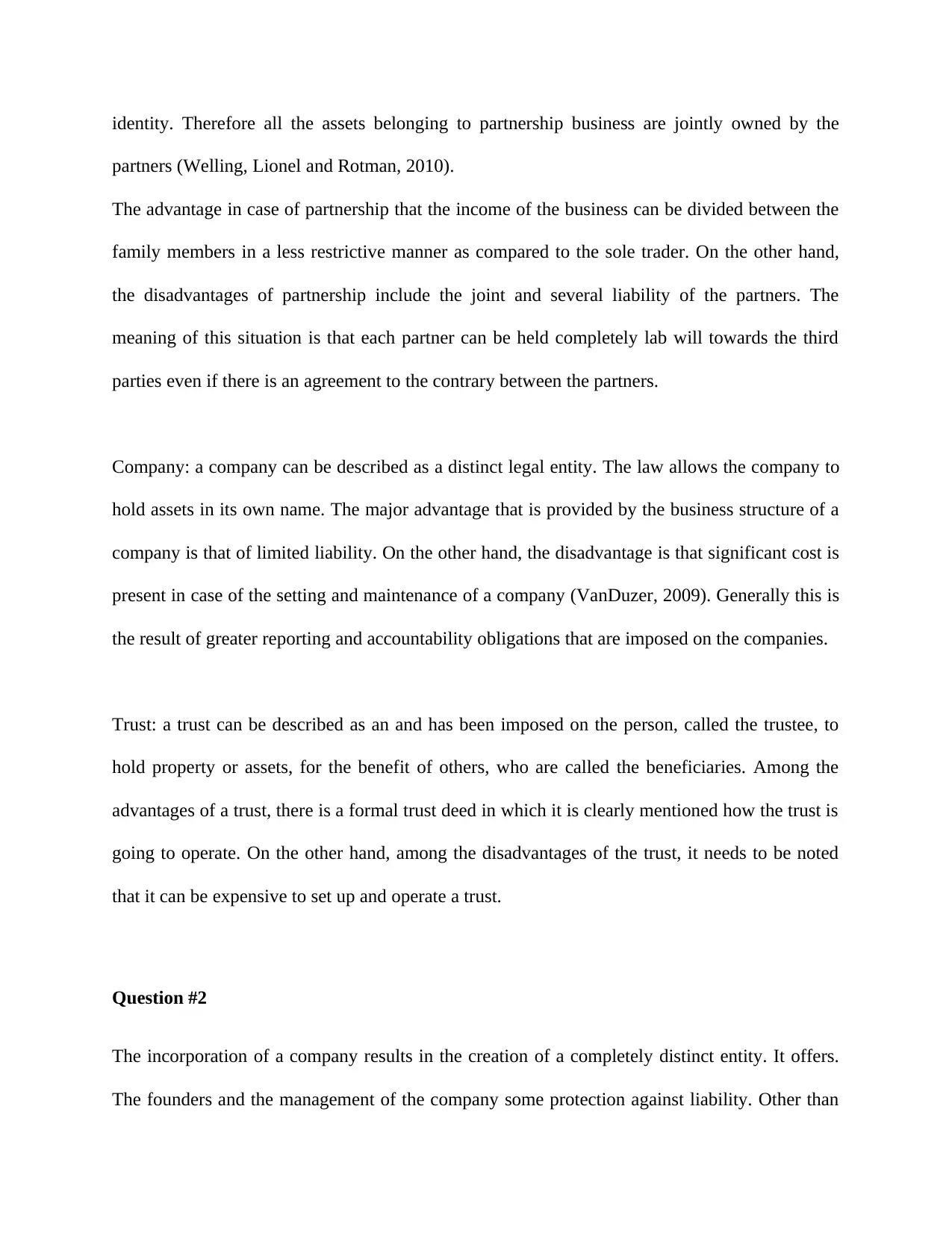
identity. Therefore all the assets belonging to partnership business are jointly owned by the
partners (Welling, Lionel and Rotman, 2010).
The advantage in case of partnership that the income of the business can be divided between the
family members in a less restrictive manner as compared to the sole trader. On the other hand,
the disadvantages of partnership include the joint and several liability of the partners. The
meaning of this situation is that each partner can be held completely lab will towards the third
parties even if there is an agreement to the contrary between the partners.
Company: a company can be described as a distinct legal entity. The law allows the company to
hold assets in its own name. The major advantage that is provided by the business structure of a
company is that of limited liability. On the other hand, the disadvantage is that significant cost is
present in case of the setting and maintenance of a company (VanDuzer, 2009). Generally this is
the result of greater reporting and accountability obligations that are imposed on the companies.
Trust: a trust can be described as an and has been imposed on the person, called the trustee, to
hold property or assets, for the benefit of others, who are called the beneficiaries. Among the
advantages of a trust, there is a formal trust deed in which it is clearly mentioned how the trust is
going to operate. On the other hand, among the disadvantages of the trust, it needs to be noted
that it can be expensive to set up and operate a trust.
Question #2
The incorporation of a company results in the creation of a completely distinct entity. It offers.
The founders and the management of the company some protection against liability. Other than
partners (Welling, Lionel and Rotman, 2010).
The advantage in case of partnership that the income of the business can be divided between the
family members in a less restrictive manner as compared to the sole trader. On the other hand,
the disadvantages of partnership include the joint and several liability of the partners. The
meaning of this situation is that each partner can be held completely lab will towards the third
parties even if there is an agreement to the contrary between the partners.
Company: a company can be described as a distinct legal entity. The law allows the company to
hold assets in its own name. The major advantage that is provided by the business structure of a
company is that of limited liability. On the other hand, the disadvantage is that significant cost is
present in case of the setting and maintenance of a company (VanDuzer, 2009). Generally this is
the result of greater reporting and accountability obligations that are imposed on the companies.
Trust: a trust can be described as an and has been imposed on the person, called the trustee, to
hold property or assets, for the benefit of others, who are called the beneficiaries. Among the
advantages of a trust, there is a formal trust deed in which it is clearly mentioned how the trust is
going to operate. On the other hand, among the disadvantages of the trust, it needs to be noted
that it can be expensive to set up and operate a trust.
Question #2
The incorporation of a company results in the creation of a completely distinct entity. It offers.
The founders and the management of the company some protection against liability. Other than
⊘ This is a preview!⊘
Do you want full access?
Subscribe today to unlock all pages.

Trusted by 1+ million students worldwide
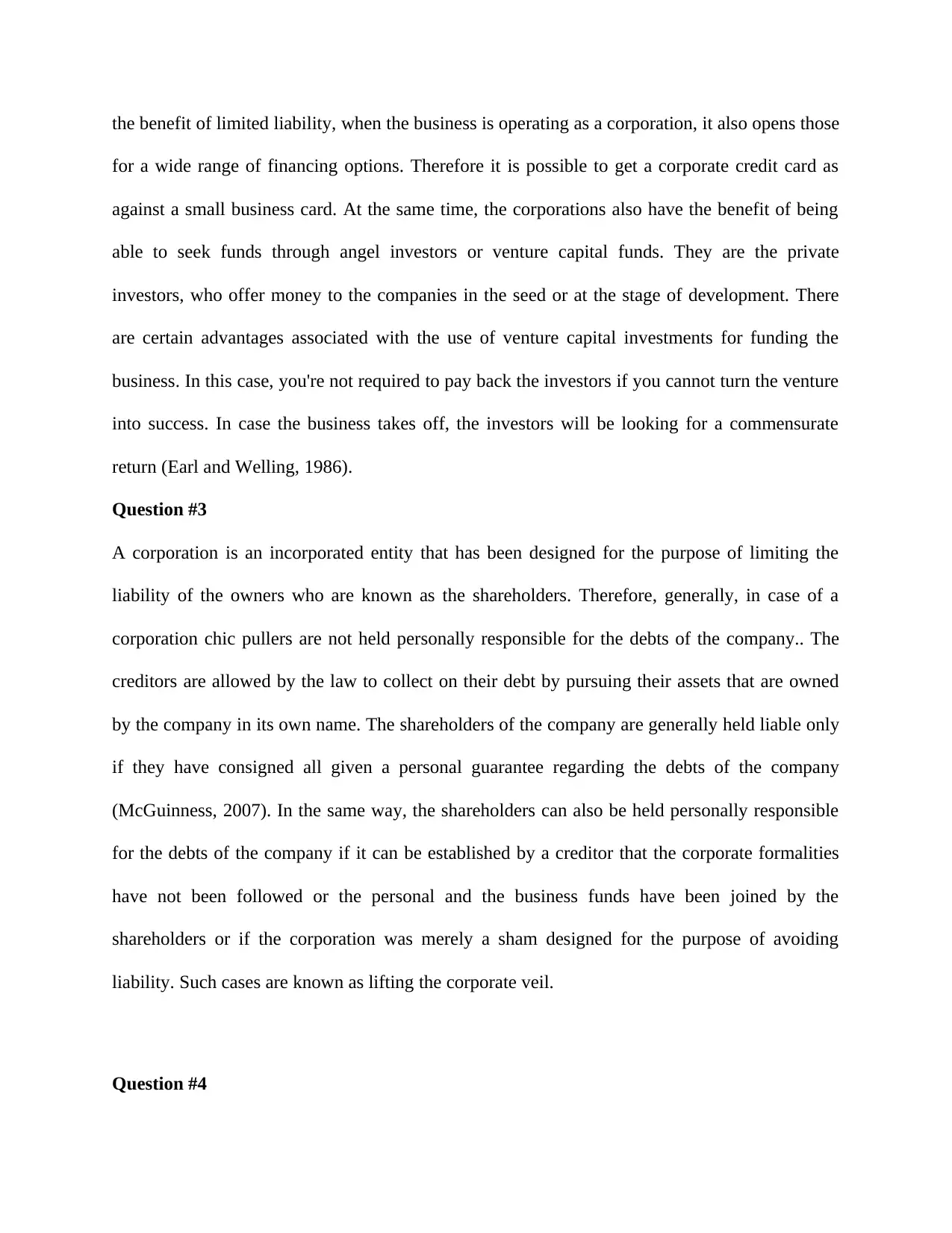
the benefit of limited liability, when the business is operating as a corporation, it also opens those
for a wide range of financing options. Therefore it is possible to get a corporate credit card as
against a small business card. At the same time, the corporations also have the benefit of being
able to seek funds through angel investors or venture capital funds. They are the private
investors, who offer money to the companies in the seed or at the stage of development. There
are certain advantages associated with the use of venture capital investments for funding the
business. In this case, you're not required to pay back the investors if you cannot turn the venture
into success. In case the business takes off, the investors will be looking for a commensurate
return (Earl and Welling, 1986).
Question #3
A corporation is an incorporated entity that has been designed for the purpose of limiting the
liability of the owners who are known as the shareholders. Therefore, generally, in case of a
corporation chic pullers are not held personally responsible for the debts of the company.. The
creditors are allowed by the law to collect on their debt by pursuing their assets that are owned
by the company in its own name. The shareholders of the company are generally held liable only
if they have consigned all given a personal guarantee regarding the debts of the company
(McGuinness, 2007). In the same way, the shareholders can also be held personally responsible
for the debts of the company if it can be established by a creditor that the corporate formalities
have not been followed or the personal and the business funds have been joined by the
shareholders or if the corporation was merely a sham designed for the purpose of avoiding
liability. Such cases are known as lifting the corporate veil.
Question #4
for a wide range of financing options. Therefore it is possible to get a corporate credit card as
against a small business card. At the same time, the corporations also have the benefit of being
able to seek funds through angel investors or venture capital funds. They are the private
investors, who offer money to the companies in the seed or at the stage of development. There
are certain advantages associated with the use of venture capital investments for funding the
business. In this case, you're not required to pay back the investors if you cannot turn the venture
into success. In case the business takes off, the investors will be looking for a commensurate
return (Earl and Welling, 1986).
Question #3
A corporation is an incorporated entity that has been designed for the purpose of limiting the
liability of the owners who are known as the shareholders. Therefore, generally, in case of a
corporation chic pullers are not held personally responsible for the debts of the company.. The
creditors are allowed by the law to collect on their debt by pursuing their assets that are owned
by the company in its own name. The shareholders of the company are generally held liable only
if they have consigned all given a personal guarantee regarding the debts of the company
(McGuinness, 2007). In the same way, the shareholders can also be held personally responsible
for the debts of the company if it can be established by a creditor that the corporate formalities
have not been followed or the personal and the business funds have been joined by the
shareholders or if the corporation was merely a sham designed for the purpose of avoiding
liability. Such cases are known as lifting the corporate veil.
Question #4
Paraphrase This Document
Need a fresh take? Get an instant paraphrase of this document with our AI Paraphraser
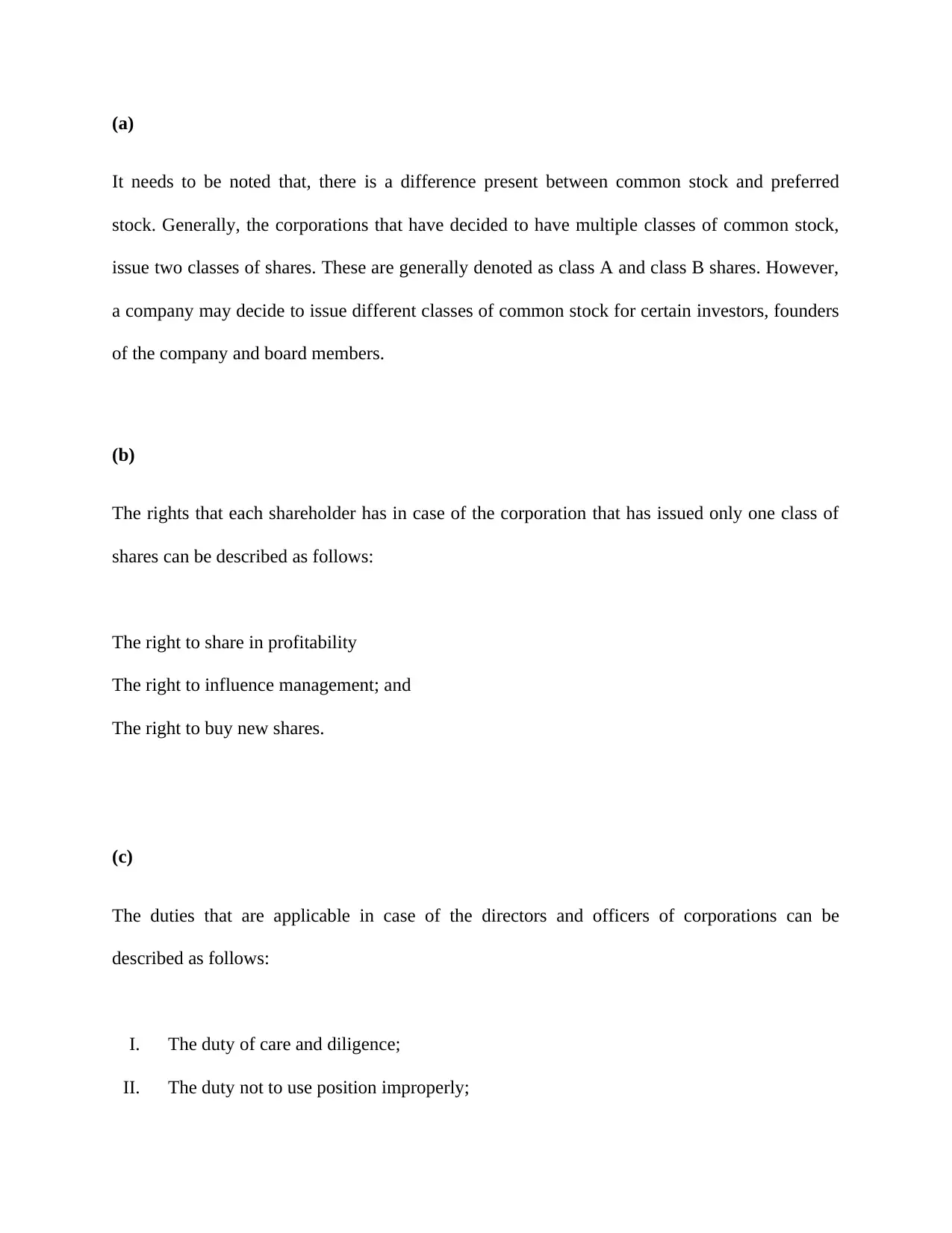
(a)
It needs to be noted that, there is a difference present between common stock and preferred
stock. Generally, the corporations that have decided to have multiple classes of common stock,
issue two classes of shares. These are generally denoted as class A and class B shares. However,
a company may decide to issue different classes of common stock for certain investors, founders
of the company and board members.
(b)
The rights that each shareholder has in case of the corporation that has issued only one class of
shares can be described as follows:
The right to share in profitability
The right to influence management; and
The right to buy new shares.
(c)
The duties that are applicable in case of the directors and officers of corporations can be
described as follows:
I. The duty of care and diligence;
II. The duty not to use position improperly;
It needs to be noted that, there is a difference present between common stock and preferred
stock. Generally, the corporations that have decided to have multiple classes of common stock,
issue two classes of shares. These are generally denoted as class A and class B shares. However,
a company may decide to issue different classes of common stock for certain investors, founders
of the company and board members.
(b)
The rights that each shareholder has in case of the corporation that has issued only one class of
shares can be described as follows:
The right to share in profitability
The right to influence management; and
The right to buy new shares.
(c)
The duties that are applicable in case of the directors and officers of corporations can be
described as follows:
I. The duty of care and diligence;
II. The duty not to use position improperly;
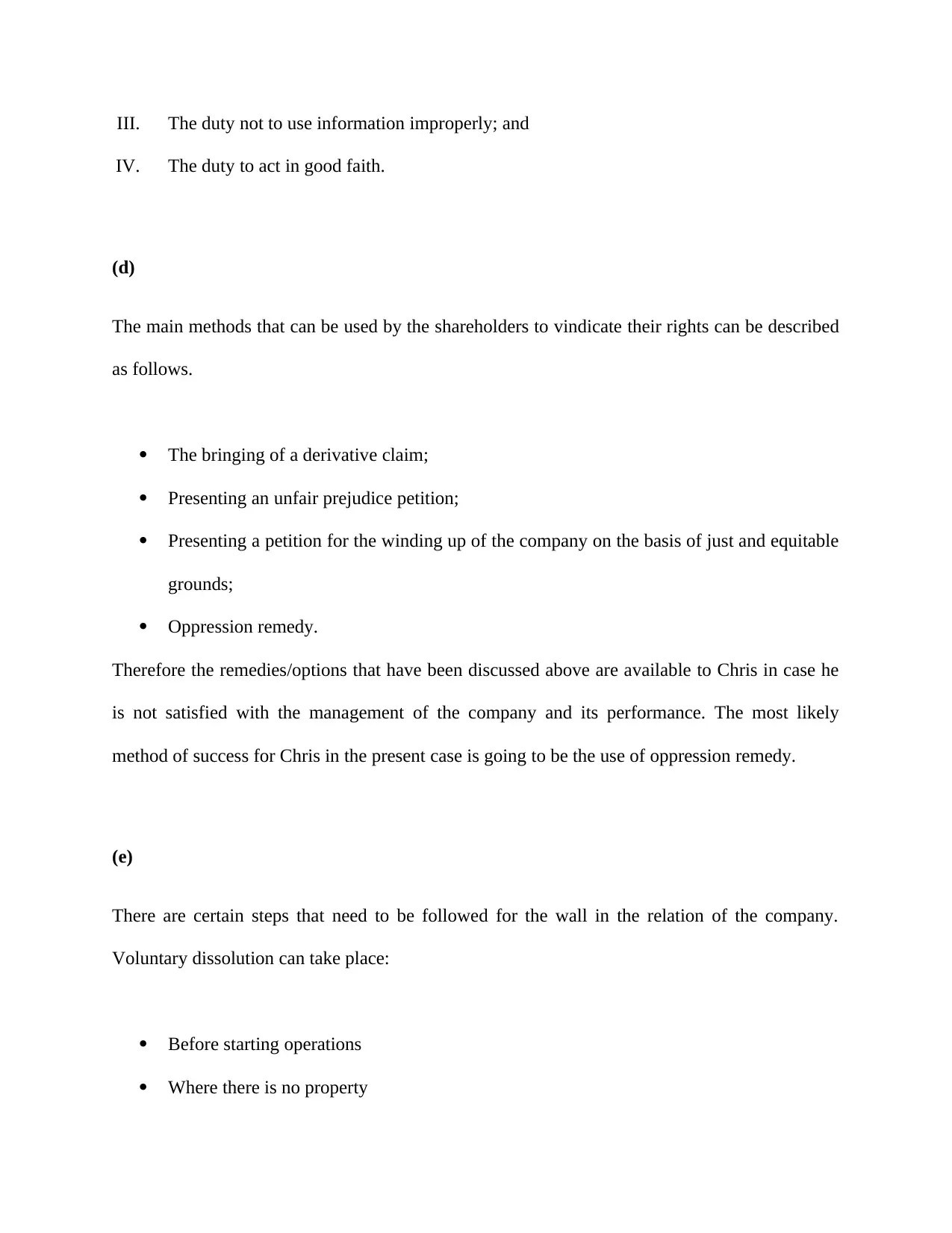
III. The duty not to use information improperly; and
IV. The duty to act in good faith.
(d)
The main methods that can be used by the shareholders to vindicate their rights can be described
as follows.
The bringing of a derivative claim;
Presenting an unfair prejudice petition;
Presenting a petition for the winding up of the company on the basis of just and equitable
grounds;
Oppression remedy.
Therefore the remedies/options that have been discussed above are available to Chris in case he
is not satisfied with the management of the company and its performance. The most likely
method of success for Chris in the present case is going to be the use of oppression remedy.
(e)
There are certain steps that need to be followed for the wall in the relation of the company.
Voluntary dissolution can take place:
Before starting operations
Where there is no property
IV. The duty to act in good faith.
(d)
The main methods that can be used by the shareholders to vindicate their rights can be described
as follows.
The bringing of a derivative claim;
Presenting an unfair prejudice petition;
Presenting a petition for the winding up of the company on the basis of just and equitable
grounds;
Oppression remedy.
Therefore the remedies/options that have been discussed above are available to Chris in case he
is not satisfied with the management of the company and its performance. The most likely
method of success for Chris in the present case is going to be the use of oppression remedy.
(e)
There are certain steps that need to be followed for the wall in the relation of the company.
Voluntary dissolution can take place:
Before starting operations
Where there is no property
⊘ This is a preview!⊘
Do you want full access?
Subscribe today to unlock all pages.

Trusted by 1+ million students worldwide
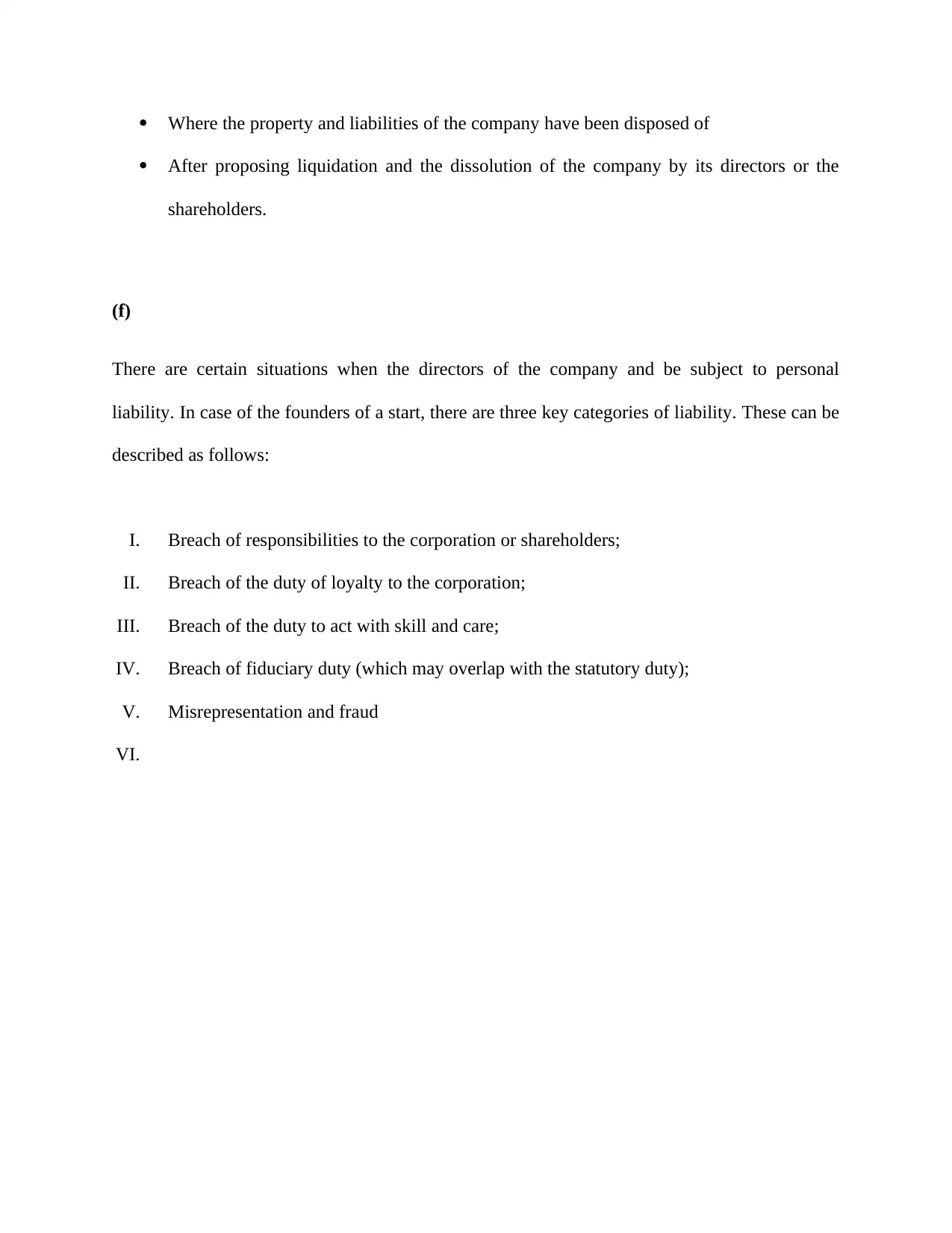
Where the property and liabilities of the company have been disposed of
After proposing liquidation and the dissolution of the company by its directors or the
shareholders.
(f)
There are certain situations when the directors of the company and be subject to personal
liability. In case of the founders of a start, there are three key categories of liability. These can be
described as follows:
I. Breach of responsibilities to the corporation or shareholders;
II. Breach of the duty of loyalty to the corporation;
III. Breach of the duty to act with skill and care;
IV. Breach of fiduciary duty (which may overlap with the statutory duty);
V. Misrepresentation and fraud
VI.
After proposing liquidation and the dissolution of the company by its directors or the
shareholders.
(f)
There are certain situations when the directors of the company and be subject to personal
liability. In case of the founders of a start, there are three key categories of liability. These can be
described as follows:
I. Breach of responsibilities to the corporation or shareholders;
II. Breach of the duty of loyalty to the corporation;
III. Breach of the duty to act with skill and care;
IV. Breach of fiduciary duty (which may overlap with the statutory duty);
V. Misrepresentation and fraud
VI.
Paraphrase This Document
Need a fresh take? Get an instant paraphrase of this document with our AI Paraphraser
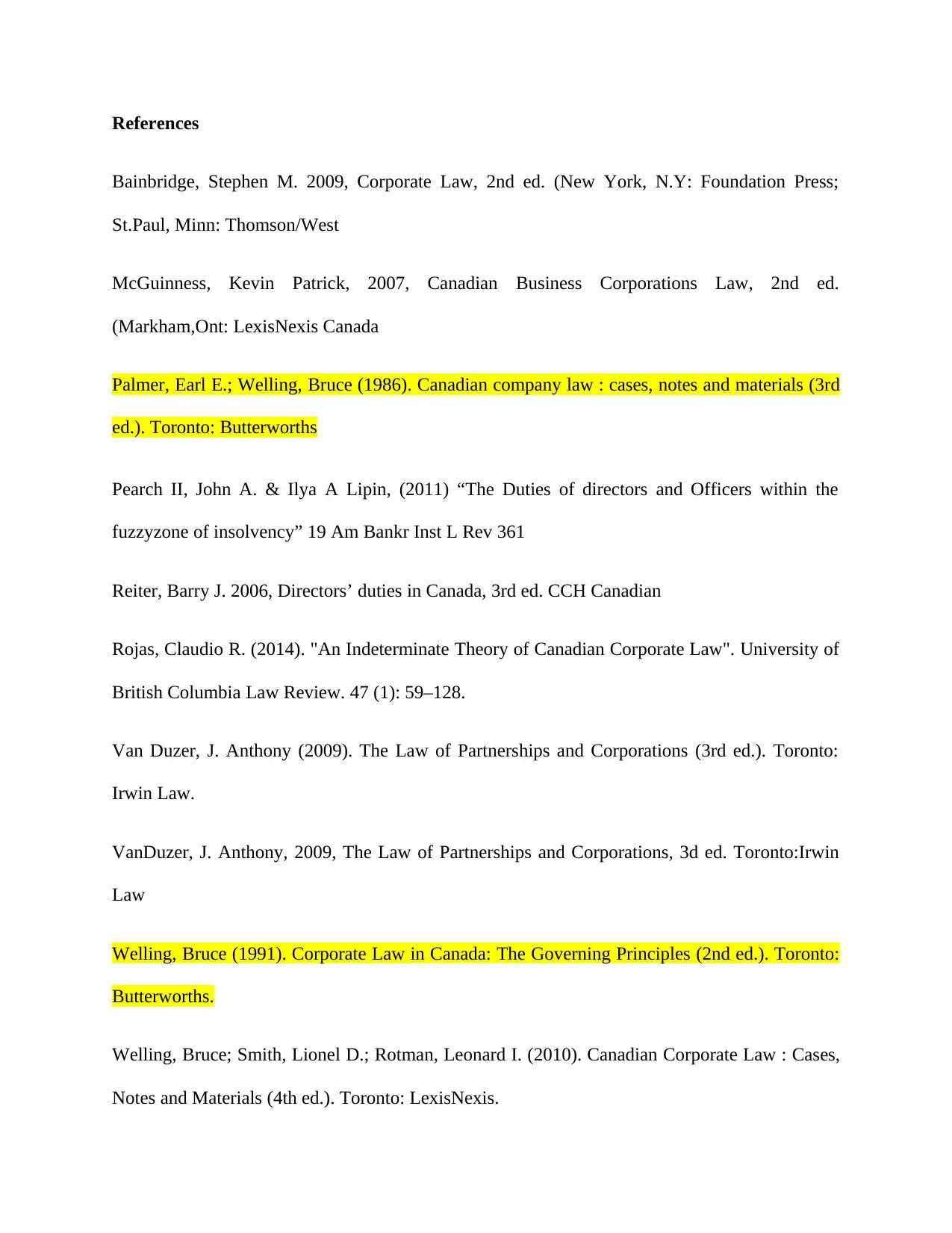
References
Bainbridge, Stephen M. 2009, Corporate Law, 2nd ed. (New York, N.Y: Foundation Press;
St.Paul, Minn: Thomson/West
McGuinness, Kevin Patrick, 2007, Canadian Business Corporations Law, 2nd ed.
(Markham,Ont: LexisNexis Canada
Palmer, Earl E.; Welling, Bruce (1986). Canadian company law : cases, notes and materials (3rd
ed.). Toronto: Butterworths
Pearch II, John A. & Ilya A Lipin, (2011) “The Duties of directors and Officers within the
fuzzyzone of insolvency” 19 Am Bankr Inst L Rev 361
Reiter, Barry J. 2006, Directors’ duties in Canada, 3rd ed. CCH Canadian
Rojas, Claudio R. (2014). "An Indeterminate Theory of Canadian Corporate Law". University of
British Columbia Law Review. 47 (1): 59–128.
Van Duzer, J. Anthony (2009). The Law of Partnerships and Corporations (3rd ed.). Toronto:
Irwin Law.
VanDuzer, J. Anthony, 2009, The Law of Partnerships and Corporations, 3d ed. Toronto:Irwin
Law
Welling, Bruce (1991). Corporate Law in Canada: The Governing Principles (2nd ed.). Toronto:
Butterworths.
Welling, Bruce; Smith, Lionel D.; Rotman, Leonard I. (2010). Canadian Corporate Law : Cases,
Notes and Materials (4th ed.). Toronto: LexisNexis.
Bainbridge, Stephen M. 2009, Corporate Law, 2nd ed. (New York, N.Y: Foundation Press;
St.Paul, Minn: Thomson/West
McGuinness, Kevin Patrick, 2007, Canadian Business Corporations Law, 2nd ed.
(Markham,Ont: LexisNexis Canada
Palmer, Earl E.; Welling, Bruce (1986). Canadian company law : cases, notes and materials (3rd
ed.). Toronto: Butterworths
Pearch II, John A. & Ilya A Lipin, (2011) “The Duties of directors and Officers within the
fuzzyzone of insolvency” 19 Am Bankr Inst L Rev 361
Reiter, Barry J. 2006, Directors’ duties in Canada, 3rd ed. CCH Canadian
Rojas, Claudio R. (2014). "An Indeterminate Theory of Canadian Corporate Law". University of
British Columbia Law Review. 47 (1): 59–128.
Van Duzer, J. Anthony (2009). The Law of Partnerships and Corporations (3rd ed.). Toronto:
Irwin Law.
VanDuzer, J. Anthony, 2009, The Law of Partnerships and Corporations, 3d ed. Toronto:Irwin
Law
Welling, Bruce (1991). Corporate Law in Canada: The Governing Principles (2nd ed.). Toronto:
Butterworths.
Welling, Bruce; Smith, Lionel D.; Rotman, Leonard I. (2010). Canadian Corporate Law : Cases,
Notes and Materials (4th ed.). Toronto: LexisNexis.

Dickinson v Dodds (1876) 2 Ch D 463
⊘ This is a preview!⊘
Do you want full access?
Subscribe today to unlock all pages.

Trusted by 1+ million students worldwide
1 out of 12
Related Documents
Your All-in-One AI-Powered Toolkit for Academic Success.
+13062052269
info@desklib.com
Available 24*7 on WhatsApp / Email
![[object Object]](/_next/static/media/star-bottom.7253800d.svg)
Unlock your academic potential
Copyright © 2020–2025 A2Z Services. All Rights Reserved. Developed and managed by ZUCOL.



